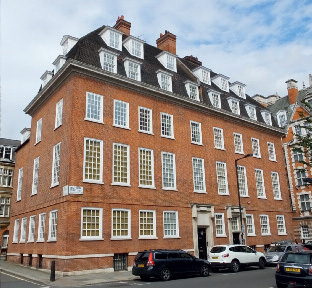Francis McLaren’s Lutyens-designed headboard at Busbridge churchyard © Tim Skelton
8 College Street, London, formerly house of Francis and Barbara McLaren © James Brazier
Lutyens’s Work for the Jekyll Extended Family
By James Brazier
Richard Page’s reference in the Summer Newsletter to Mulberry House, Westminster having been built by Edwin Lutyens for MP Reginald McKenna (1863-1943) prompted me to contact the editor, and this article is the consequence of that. A study of some commissions Lutyens was given through his close association with Gertrude Jekyll (1843-1932) illustrates just how successful he was as a networker and how one commission progressively led to another, particularly within the Jekyll extended family.
When Lutyens first met Jekyll in 1889 and was later commissioned by her to build Munstead Wood (completed in 1896), he could hardly have foreseen how his connection with her family would develop. Gertrude was the brother of Sir Herbert Jekyll (1846-1932) who, with his artist wife Agnes, née Graham (1861-1937), had two daughters, Barbara and Pamela. They also had a son, Francis, who never married but continued to live at the family home, Munstead House. He wrote a very good book on Miss Jekyll, Gertrude Jekyll: a Memoir (1934). This article is largely about Lutyens’s work resulting from Barbara and Pamela’s influence.
An early Lutyens commission was the headstone marking the grave of Julia Jekyll (1813-1895), mother of Herbert and Gertrude, at Busbridge churchyard near Munstead. It was to be the first of a number of Lutyens designed grave-markers there for the Jekyll extended family.
Barbara married the Hon Francis McLaren MP in 1911 and Pamela Reginald McKenna in 1908. McLaren’s sister, Florence, married Sir Henry Norman in 1907. All three men were Liberal MPs and required London townhouses, ideally in Westminster, and Lutyens was commissioned to design them. All were built in 1911. These consist of two houses forming a single composition, known as 8 Little College Street (for the McLarens), and The Corner House, Cowley Street, now at 10 Great Peter Street (for the Normans), and 36 Smith Square (the McKennas), which is only a short walk away.
The Great War broke out with disastrous consequences for the McLaren family when Francis was killed in a flying accident at Montrose, Scotland while serving as a second lieutenant in the Royal Flying Corps. Francis was buried with full military honours at Busbridge churchyard a few feet from the grave of Julia Jekyll. Lutyens was engaged to design a headboard to mark Francis’s grave and this sparked my interest in the Lutyens-Jekyll connections. When I first found this oak five-panelled headboard around 25 years ago, it was beginning to show its age but, because it was adjacent to the Jekyll plot containing the graves of Gertrude and Herbert’s family, I felt there had to be a connection between the two families and, importantly, that Lutyens had probably designed the Grade II-listed wooden headboard. I later received confirmation from Margaret Richardson that it was indeed Lutyens’s work. I’m pleased to say it subsequently underwent extensive professional restoration and was rededicated in 2000.
Pamela’s husband was chairman of Midland Bank, which commissioned Lutyens to build its HQ at Poultry in the City and three branches — in Piccadilly and Leadenhall Street in London and King Street, Manchester. McKenna also commissioned Lutyens to build Mells Park House on the Mells estate in Somerset. Francis McLaren’s parliamentary constituency was Spalding and it was through Barbara’s influence (and financial contributions) that Lutyens was commissioned to design the impressive Spalding War Memorial. Lutyens also designed war
memorials at Busbridge and Wargrave, where the Jekyll family once lived. Had McLaren not died in the war, it’s probable that he, too, would have commissioned Lutyens to build him a country house.
Other Lutyens commissions that can be traced back to the Jekyll family include those from the Graham family. Agnes Graham’s sister, Frances, married Sir John Horner. It was Horner’s family who owned the Mells estate, and John let the old house to his niece Pamela and Reginald for a nominal rent on the condition that they rebuilt Park House. Lutyens’s resulting redesign, in a neoclassical style, was built in 1925. Among other Lutyens commissions from the Horner connection was the plinth in Mells Church supporting the fine equestrian statue by Alfred Munnings of John’s son, Edward, who also lost his life in the war. And Lutyens designed a number of public buildings in Mells which, undoubtedly, were commissioned by the Horner family. But the best thing at Mells is the McKenna family grave in St Andrew’s churchyard of 1932.
No doubt further Lutyens commissions can be traced from the Jekyll family but, in this short article, it’s not possible to explore this intriguing and revealing subject fully.




